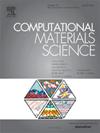锂和过渡金属嵌入对孪生石墨烯电子和热传输特性的影响
IF 3.1
3区 材料科学
Q2 MATERIALS SCIENCE, MULTIDISCIPLINARY
引用次数: 0
摘要
有效而稳健地调节各种特性对于碳基低维材料的器件应用至关重要。在这项工作中,通过第一性原理计算和分子动力学模拟,系统地阐明了锂原子和三维过渡金属(TM)原子嵌入孪晶石墨烯碳纳米笼的情况,以及对结构、电子和晶格热传输特性的影响。结果表明,锂、钛、钒、锰和铁嵌入的碳纳米笼在孪生石墨烯中呈现出能量稳定的构型,与表面吸附相比,评估的嵌入能垒也意味着更高的动态稳定性。自旋极化计算表明,V-装饰体系具有半金属特性,而电子结构可从金属行为进一步调整为半导体行为。此外,嵌入还能有效改变晶格热导率,在室温下可实现 38%/47% 的增强/抑制。因此,我们的研究结果表明,通过利用碳纳米笼,基于石墨烯的孪生应用具有巨大的潜力,并为调整低维碳网络的各种物理性质铺平了新的道路,而不仅仅是表面吸附。本文章由计算机程序翻译,如有差异,请以英文原文为准。

Effect of lithium and transition metals embedding on electronic and thermal transport properties of twin graphene
The effective and robust modulation of various properties is crucial for device applications of carbon-based low-dimensional materials. In this work, the embedding of lithium and 3d transition metal (TM) atoms into carbon nanocages of twin graphene, as well as effects on structural, electronic, and lattice thermal transport properties, have been systematically clarified through first-principles calculations and molecular dynamics simulations. The results indicate that the Li, Ti, V, Mn, and Fe-embedded carbon nanocages exhibit energetic stable configurations for the twin graphene, and the evaluated energy barrier for the embedding also implies more dynamic stability compared to surface adsorption. Spin-polarized calculations demonstrate a half-metallic feature in the V-decorated system, while the electronic structure can be further tuned from metallic behavior to semiconductor. Moreover, the lattice thermal conductivity can also be effectively altered by the embedding, and an enhancement/suppression of 38 %/47 % can be achieved at room temperature. Thus, our results indicate great potential for twin graphene-based applications via the utilization of carbon nanocages, and pave new ways to tune various physical properties of low-dimensional carbon networks beyond surface adsorption.
求助全文
通过发布文献求助,成功后即可免费获取论文全文。
去求助
来源期刊

Computational Materials Science
工程技术-材料科学:综合
CiteScore
6.50
自引率
6.10%
发文量
665
审稿时长
26 days
期刊介绍:
The goal of Computational Materials Science is to report on results that provide new or unique insights into, or significantly expand our understanding of, the properties of materials or phenomena associated with their design, synthesis, processing, characterization, and utilization. To be relevant to the journal, the results should be applied or applicable to specific material systems that are discussed within the submission.
 求助内容:
求助内容: 应助结果提醒方式:
应助结果提醒方式:


